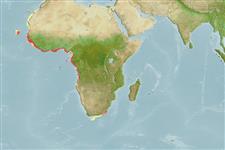>
Eupercaria/misc (Various families in series Eupercaria) >
Haemulidae (Grunts) > Haemulinae
Etymology: Pomadasys: Greek, poma, -atos = cover, operculum + Greek, dasys = with hair (Ref. 45335).
More on author: Cuvier.
Environment: milieu / climate zone / depth range / distribution range
Ecologie
marien; brak water benthopelagisch; diepte ? - 250 m (Ref. 27000), usually ? - 100 m (Ref. 27000). Tropical
Eastern Atlantic: west coast of Africa, from Senegal to Angola (Ref. 57395). Also reported from Mauritania (Ref. 5377).
Lengte bij maturiteit / Grootte / Gewicht / Leeftijd
Maturity: Lm 15.5 range ? - ? cm
Max length : 36.0 cm TL mannelijk / geslacht onbekend; (Ref. 5476); common length : 30.0 cm TL mannelijk / geslacht onbekend; (Ref. 5476)
Dorsale stekels (totaal) : 11 - 13; Dorsale zachte stralen (totaal) : 15 - 17; Anale stekels: 3; Anale zachte stralen: 9 - 10; Wervels: 27. Diagnosis: body oblong and compressed; snout rather short, about equal to eye diameter; 2 anterior pores on chin, followed by a median pit bearing openings of another pair of pores (Ref. 57395). A pore above posterior end of maxilla and under preorbital bone; last dorsal spine about the same length or even shorter, exceptionally somewhat longer, than penultimate one (Ref. 81655). 2nd anal fin spine longer and stouter than 3rd (Ref. 57395, 81655), third anal spine mostly much thinner (Ref. 81655). Caudal fin forked; scales slightly ctenoid; 6-8 scale rows between lateral line and middle of spinous dorsal-fin base (Ref. 57395).
Found over sand and mud (Ref. 2683) in coastal waters (Ref. 2683, 57395). Enters estuaries and lagoons (Ref. 2135, 57395). Feeds on other fish (Ref. 5377), shrimps, crabs, mollusks, annelids, zooplankton and detritus (Ref. 28587). Often confused with P. jubelini (Ref. 57395).
Levenscyclus en paargedrag
Maturities | Voortplanting | Spawnings | Egg(s) | Fecundities | Larven
Oviparous, distinct pairing during breeding (Ref. 205).
Roux, C., 1990. Haemulidae. p. 783-788. In J.C. Quero, J.C. Hureau, C. Karrer, A. Post and L. Saldanha (eds.) Check-list of the fishes of the eastern tropical Atlantic (CLOFETA). JNICT, Lisbon; SEI, Paris; and UNESCO, Paris. Vol. 2. (Ref. 6946)
Status op de Rode Lijst van het IUCN (Ref. 130435)
Gevaar voor de mens
Harmless
Gebruik door de mens
Visserij: commercieel
Tools
Speciale rapporten
Download XML
Internetbronnen
Estimates based on models
Preferred temperature (Ref.
123201): 15.6 - 20.8, mean 17.9 °C (based on 36 cells).
Fylogenetische diversiteitsindex (Ref.
82804): PD
50 = 0.5000 [Uniqueness, from 0.5 = low to 2.0 = high].
Bayesian length-weight: a=0.01445 (0.00668 - 0.03127), b=2.99 (2.82 - 3.16), in cm total length, based on LWR estimates for this Genus-body shape (Ref.
93245).
Trofisch niveau (Ref.
69278): 3.3 ±0.49 se; based on food items.
Weerstandsvermogen (Ref.
120179): Gemiddeld, minimale populatieverdubbelingstijd 1,4-4,4 jaar (Preliminary K or Fecundity.).
Fishing Vulnerability (Ref.
59153): Low to moderate vulnerability (26 of 100).
Nutrients (Ref.
124155): Calcium = 91.5 [19.6, 181.2] mg/100g; Iron = 0.828 [0.422, 1.595] mg/100g; Protein = 17.9 [16.1, 19.8] %; Omega3 = 0.269 [0.125, 0.489] g/100g; Selenium = 69.2 [36.2, 130.1] μg/100g; VitaminA = 30.8 [13.4, 69.1] μg/100g; Zinc = 1.51 [1.03, 2.21] mg/100g (wet weight);
